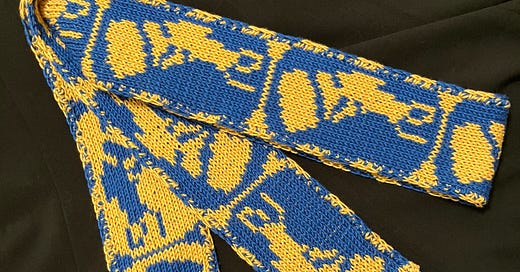Queen Nefertiti, also known as Neferneferuaten-Nefertiti, (𓏏𓈖𓇳𓇋𓄤𓄤𓄤𓄤 𓄤𓇍𓏏𓏭𓁐) is probably one of the most recognizable Egyptian queens. The inspiration for this scarf is her portrait bust on display in the Neues Museum in Berlin, Germany.
Nefertiti was the Great Royal Wife of the Pharaoh Akhenaten. Ahkenaten and Nefertiti are remembered for their revolution in Ancient Egypt’s religion, politics, and art.
Ancient Egyptian culture had maintained its polytheistic religion for generations before Nefertiti and her husband, then known as Amenhotep IV, took the throne. Perhaps in response to the growing power of the priests of the god Amun or perhaps in an act of devotion, the pharaoh and his wife took Ancient Egypt in a drastically different direction. The king changed his name to Akhenaten and introduced what is sometimes called the first monotheistic religion. Rather than worshiping many gods and goddesses, Ancient Egyptians would now worship the sun disk known as the Aten. Akhenaten and Nefertiti moved the capital city to Akhetaten, known today as Amarna, and built temples to the sun disk.
Their revolution also influenced the art of their time. Nefertiti’s portrait bust is just one example. Akhenaten and his wife Nefertiti presented themselves and their children with different facial features and a much more voluptuous style than other royal families. In the background of their portraiture you often see the Aten sun disk with its rays reaching through the sky.
Egyptologists have debated several theories about Queen Nefertiti. Some say she may have succeeded Ahkenaten after his death as the pharaoh Smenkhkare. Others theorize that the pharaoh Tutankhamun, Akhenaten’s son, may have been buried in a chamber of Queen Nefertiti’s tomb. Part of the challenge of investigating this period in Egyptian history was the contemporary backlash to Akhenaten’s and Nefertiti’s political and religious revolution: after they died, people damaged or destroyed much of the Amarna era monuments and statuary. King Tutankhamun and his regents restored Ancient Egypt’s polytheism and moved the capital city back to Thebes (modern day Luxor).
I encourage you to read more about Ancient Egyptian philosophy, as a social media post can’t do justice to the nuances of an ancient religion.
Nefertiti scarves are available with limited inventory or made-to-order in my Etsy shop.
A portion of the proceeds from each sale benefits the Theban Mapping Project Library, which provides books and literacy programs to the locals of Luxor, Egypt.
Facebook · Instagram · Twitter
References: Wikipedia, Brittanica, Neues Museum
Images © 2023 EEWL
#ancientegypt #ancientegyptians #egypteantique #anticoegitto #egizi #egypte #egipto #egitto #egyptology #archaeology #mythology #hieroglyphs #hieroglyph #kingtut #kingtutankhamun #tutankhamun #eewl #notjustknitting #fashionscarf #fashion #fiberartist #yarnlove #knittersofinstagram #knitting_inspiration #knitstagram #aten #amarna #akhenaten #nefertiti #smenkhkare #meritaten #amenhotep #amenhotepiv #etsy




